

Energy in Australia - Origin Energy. In fact, around 86 percent of our electricity is generated from these fuels types, with 73 percent from coal and 13 percent from natural gas.1 Around the world it’s much the same, with fossil fuels being used for electricity, heating and powering vehicles.
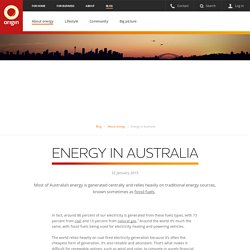
The world relies heavily on coal fired electricity generation because it’s often the cheapest form of generation. It’s also reliable and abundant. That’s what makes it difficult for renewable options, such as wind and solar, to compete in purely financial term Renewable energy sources make up the remaining 14 percent of Australia’s electricity mix.2 Hydropower, which began contributing to Australia’s generation in the 1950s, is the largest source of renewable electricity, contributing 60 percent of all renewable generation and 7 percent of total electricity.
Wind, bioenergy and rooftop solar make up the other seven percent. Electricity generation across Australia3. Wind power in Australia - Origin Energy. This increase will likely be due to the Renewable Energy Target (RET), which has the goal of sourcing 20 percent of Australia’s electricity from renewable energy sources by 2020.
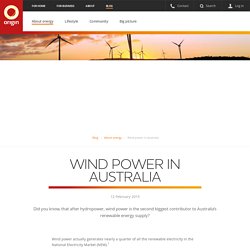
Because wind energy has a relatively low cost and is proven technology, when compared with other renewable energy sources, it’s likely to be the main type of electricity development delivered under the RET. At the end of 2012, there was about 2,200 megawatts of wind generation capacity in the NEM with roughly another 1,800 megawatts of wind capacity under construction.3 If no other technologies contribute to the RET, many billions of dollars of private sector investment will be required to deliver about 8,000 megawatts of additional wind generation capacity. This is roughly equivalent to four times the wind capacity that was in place at the end of 2012.
Assuming that each new wind turbine has a capacity of 3 megawatts, this translates to an extra 2,600 wind turbines that need to start operating by 2020. Wind energy - Origin Energy. Wind turbines are typically about 120 metres high to capture stronger winds and their blades span about 45 metres.
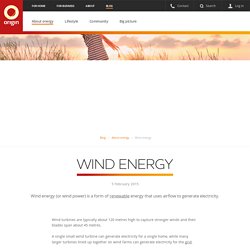
A single small wind turbine can generate electricity for a single home, while many larger turbines lined up together on wind farms can generate electricity for the grid. Clean Energy Council - Wind energy. Wind power is currently the cheapest source of large-scale renewable energy.
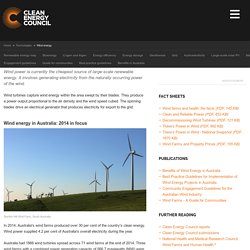
It involves generating electricity from the naturally occurring power of the wind. Wind turbines capture wind energy within the area swept by their blades. They produce a power output proportional to the air density and the wind speed cubed. The spinning blades drive an electrical generator that produces electricity for export to the grid. Wind energy in Australia: 2014 in focus Starfish Hill Wind Farm, South Australia. Tony Abbott wants fewer 'visually awful' wind farms, wishes Howard government never implemented Renewable Energy Target. Updated Prime Minister Tony Abbott has described wind farms as "visually awful", saying he wishes the Howard government, of which he was a member, had never implemented the Renewable Energy Target (RET) policy.

"When I've been up close to these things, not only are they visually awful, but they make a lot of noise," Mr Abbott told Sydney broadcaster Alan Jones on Thursday. His comments echoed those of Treasurer Joe Hockey, who last year described wind turbines as "utterly offensive". When questioned by Jones about the potential for wind turbines to affect the health of people living nearby, Mr Abbott said: "I do take your point. " The link between wind turbines and health problems has recently been examined by the National Health and Medical Research Council, which found no consistent evidence that wind farms cause adverse health effects, but said more research was warranted.
A Senate committee initiated by several independent senators is currently investigating whether a link exists. Victorian government to back new wind farms as part of renewables plan. The Andrews government is committed to buying "renewable energy certificates" to encourage new wind energy projects in Victoria.
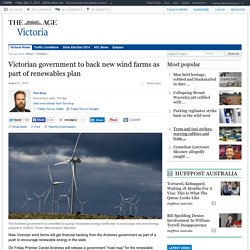
Photo: Warrnambool Standard New Victorian wind farms will get financial backing from the Andrews government as part of a push to encourage renewable energy in the state. On Friday Premier Daniel Andrews will release a government "road map" for the renewable energy industry, which is expected to include a minimum state target and some solar initiatives. As part of the announcement there will be a commitment for the government to buy "renewable energy certificates" as a way to encourage some new wind energy projects to be built Victoria. The program is expected to bring forward the building of a modest 100 megawatts of new wind energy in the state, worth $200 million in investment.
The announcement follows a rocky 18 months for the industry that has seen investment in new projects largely dry up across Australia.